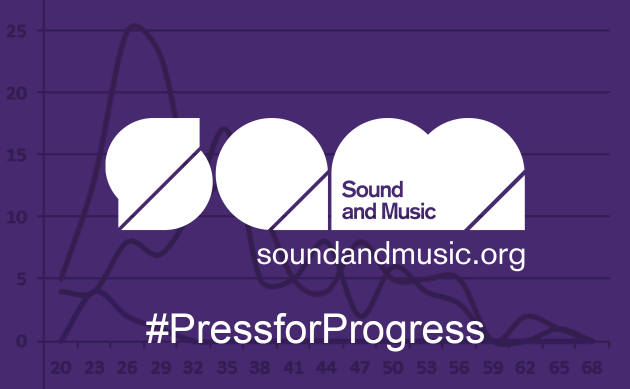Gender and Composition
As part of our month-long series of activities marking International Women’s Day 2018, below we take a closer look at the data and insights we have gathered over the past year. You can find out more about all of our IWD activities here.
In 2017, we revised and updated our Equality and Diversity Policy, which lists our wider commitments alongside our aims regarding gender equality. You can read our Chief Executive, Susanna Eastburn’s blog here, which outlines the organisation’s commitments and the urgent need for sector change. We also publicly committed to the following:
By 2020 at least 50% of the composers Sound and Music works with will identify as women.
To put this into perspective, while roughly 50% of GCSE music students are female, evidence suggests this figure drops dramatically as composers pursue their education: a 2016 study by BASCA found that the proportion of women training in composition decreases at each level of study: they made up 39% of undergraduate composers, 31% of postgraduate composers, and just 14% of PhDs.
While these figures obviously tell us nothing about composers who choose not to study academically, the trend still reveals much about imbalances in new music. Likewise, in recent years the annual average for female applicants to Sound and Music’s talent development programmes has been just 27-31%.
What have we been doing to help turn the tide?
Late last year, we launched our new talent development programme, New Voices. In shaping this opportunity, we worked closely with our Active Encouragement Group, a group of composers, coaches and mentors from a range of backgrounds, that advises us on how to approach the task of diversifying our programmes. The group was essential in helping us to develop our Pathways project, on which New Voices is based.
Together we tested ideas and revised our copy, and the group encouraged us to run a registration period prior to the application process. Members of the Active Encouragement group also worked in parallel with Sound and Music’s team and Board of Trustees on the development of our Equality and Diversity Policy. They challenged our assumptions and encouraged us to be bolder with our commitments.
Is it working?
Despite making real progress in some areas, there is no denying the reality that Sound and Music remains a long way off its gender equality target, with only 31% of applications in 2017-18 coming from women.
At the same time, there are causes for optimism. In particular, the newly revised New Voices programme received 39% of its applications from women: the highest proportion the organisation has ever received for a major talent development programme (New Voices received a total of 237 applications, and will be the major focus of our talent development work moving forwards).
New Voices: making progress on gender
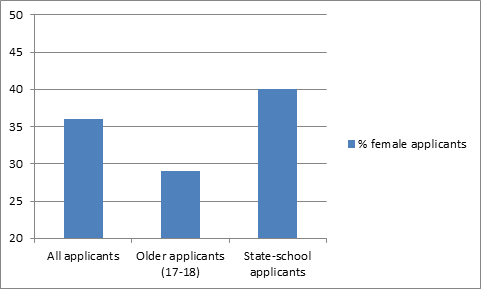
Few young female applicants
Looking more closely at the data for our New Voices applications – in this case by age range – we can see that female applicants were particularly well-represented among those over 35, accounting for 46% of all applicants in that age range (see below). Women remain most poorly represented among those in their twenties, accounting for just 24% of all applicants in this group.
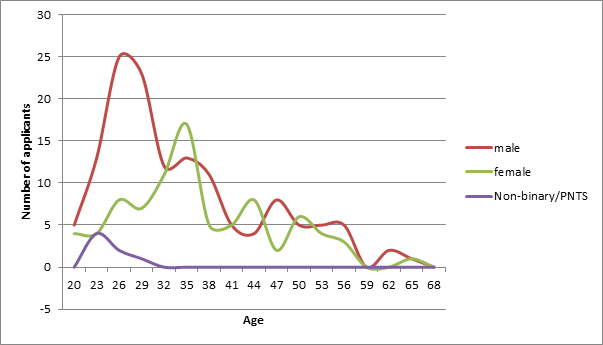
We can also compare the gender representation of our New Voices applicants by location (see below). Women represented 47% of London-based applicants, compared to just 32% of those based outside the capital.
New Voices: London applicants more gender-balanced
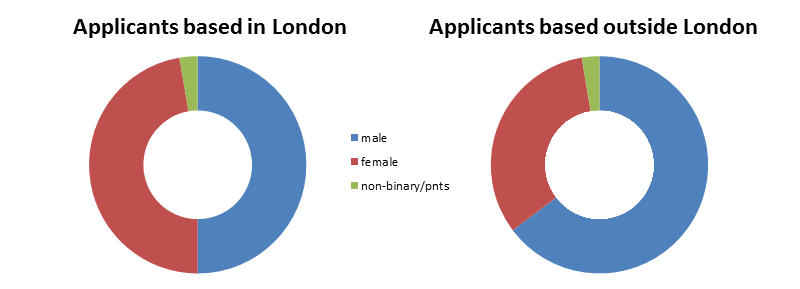
Our wider work
We can do similar kinds of analysis with the data about the applicants to our annual Summer School. In 2017, girls comprised:
– 36% of all applicants
– slightly more (40%) of all state-school applicants
– a slightly lower proportion of older applicants (29% of 17-18 year olds).
Summer School: younger, state-educated female applicants
Beyond New Voices and the Summer School, we have also been reviewing the data for our other recent composer opportunities. Below you can see the proportion of female applicants for each of our larger opportunities (defined here as those that received thirty or more applications) since 2016. (Note that some of these opportunities were issued in partnership with other organisations).
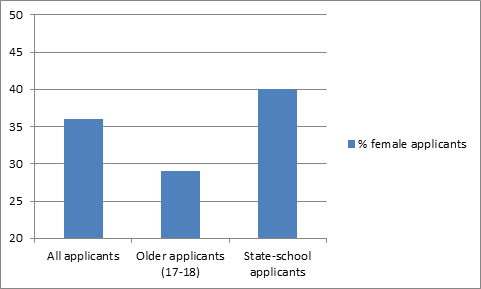
Female applicants across recent programmes
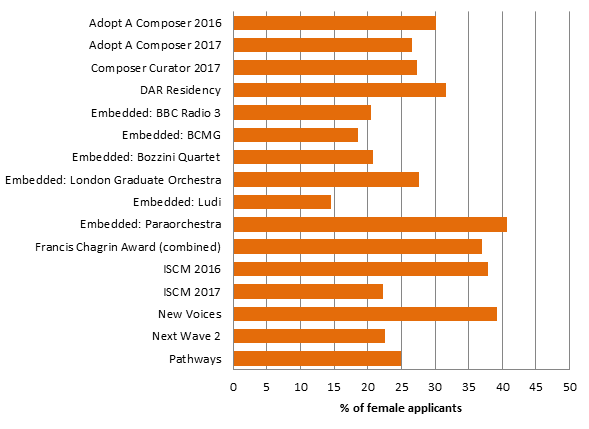
The data shows that while the overall percentage of female applicants remains disappointingly low, some programmes achieved very promising results: as well as the recent New Voices call, three other calls received more than one third of their applications from women: Embedded: Paraorchestra (2016), the ISCM shortlist (2016) and the combined applications for five rounds of the Francis Chagrin Award. In the coming months we want to look more closely at why these opportunities had a greater balance of applications, and what we can learn from this for the future.
British Music Collection: composer profiles by gender*
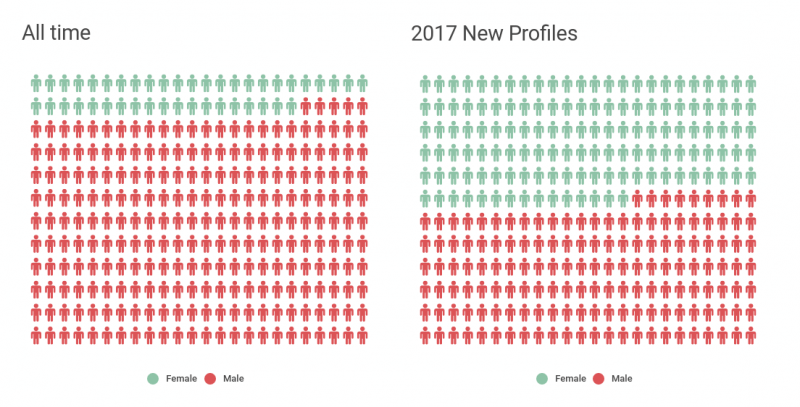
Through focused projects such as the Herstories: Re-writing British Music History events and a series of interventions for last year’s International Women’s Day , the British Music Collection is gradually becoming more gender-balanced. In 2017, 47% of new profiles that specified a gender were for female composers, a hugely promising step in the right direction. In spite of this, overall only 15% of all the composer profiles – 3,290 in total – belong to women, excluding those that do not specify a gender.
One of the challenges we face is to focus on both the contemporary and historical pictures: to encourage young composers of all genders to engage with the collection, while also working to populate the archive with women composers whose music may not have been well-represented during their lifetimes.
Challenges
One of the ongoing challenges for Sound and Music is to chart changes in the rate of engagement among women while also ensuring that we accommodate non-binary conceptions of gender. For example, for a number of months last year, the organisation trialled capturing gender fields as non-compulsory in the sign-up form for the British Music Collection. Our intention was to respect those who prefer not to specify a gender. A very large number of people did leave this field blank, and ultimately the organisation had no way of knowing how many had done so intentionally, by accident, or because it wasn’t clear how or why this data was important to us.
Another challenge for us is how we begin to use the data we gather more intelligently, to discover more about where the barriers lie. For example, our analysis of New Voices suggests that younger women and women based outside London were particularly unlikely to apply. Moving forward we want to further investigate these issues by asking additional questions of the data: where are female applicants finding out about our opportunities? What are their routes into composition? How many are first-time applicants?
Importantly, we want to ensure we combine this kind of quantitative research with a more close-up approach to understanding the complex motivations and barriers that help decide who does – and does not – pursue a career as a composer.
You can find out more about all of our IWD activities here.

